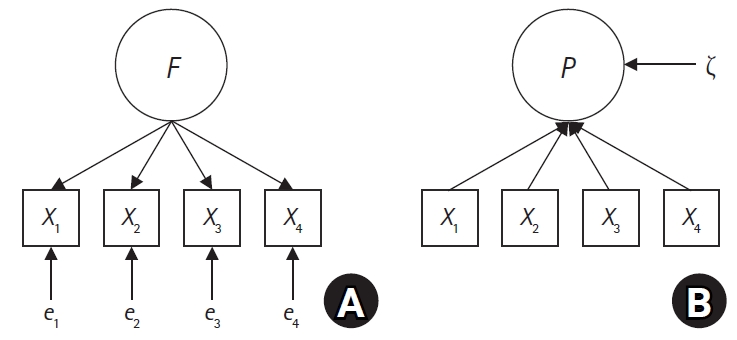-
Formative versus reflective measurement models in nursing research: a secondary data analysis of a cross-sectional study in Korea
-
Eun Seo Park, Young Il Cho, Hyo Jin Kim, YeoJin Im, Dong Hee Kim
-
J Korean Acad Nurs 2025;55(1):107-118. Published online February 19, 2025
-
DOI: https://doi.org/10.4040/jkan.24095
-
-
 Abstract Abstract
 PDF PDF ePub ePub
- Purpose
This study aimed to empirically verify the impact of measurement model selection on research outcomes and their interpretation through an analysis of children’s emotional and social problems measured by the Pediatric Symptom Checklist (PSC) using both reflective and formative measurement models. These models were represented by covariance-based structural equation modeling (CB-SEM) and partial least squares SEM (PLS-SEM), respectively.
Methods
This secondary data analysis evaluated children’s emotional and social problems as both reflective and formative constructs. Reflective models were analyzed using CB-SEM, while formative models were assessed using PLS-SEM. Comparisons between these two approaches were based on model fit and parameter estimates.
Results
In the CB-SEM analysis, which assumed a reflective measurement model, a model was not identified due to inadequate fit indices and a Heywood case, indicating improper model specification. In contrast, the PLS-SEM analysis, assuming a formative measurement model, demonstrated adequate reliability and validity with significant path coefficients, supporting the appropriateness of the formative model for the PSC.
Conclusion
The findings indicate that the PSC is more appropriately analyzed as a formative measurement model using PLS-SEM, rather than as a reflective model using CB-SEM. This study highlights the necessity of selecting an appropriate measurement model based on the theoretical and empirical characteristics of constructs in nursing research. Future research should ensure that the nature of measurement variables is accurately reflected in the choice of statistical models to improve the validity of research outcomes.
-
Untact Visit Service Development Based on an Application Reflecting the Circumstances during COVID-19: Focusing on Utilization in the Pediatric Intensive Care Units
-
Dahae Woo, Hanui Yu, Hyo Jin Kim, Minyoung Choi, Dong Hee Kim
-
J Korean Acad Nurs 2021;51(5):573-584. Published online October 31, 2021
-
DOI: https://doi.org/10.4040/jkan.21143
-
-
 Abstract Abstract
 PDF PDF
- Purpose
This study aimed to develop an untact visit service based on an application that can be utilized in the pediatric intensive care unit (PICU) during COVID-19.
Methods
This study adopted the double diamond process of service design comprising the discovery, defining, and development stages.
Results
We developed an untact visit service based on an application that considered the child’s status, schedule, photo, and video messages, and so on. Moreover, we derived a service flow regarding the required roles and the type of flow shown between each stakeholder.
Conclusion
Considering the ongoing pandemic, the untact visit service is designed to increase rapport and participation of parents, share the child’s information in real-time, and provide one-stop service without increasing healthcare providers’ work. It will be a useful visit service that can be applied and evaluated in various hospital settings and the PICU.
-
Citations
Citations to this article as recorded by  - Factors affecting pediatric nurses’ development of partnerships with parents of hospitalized children: An evaluation based on the stress-coping adaptation model
In Young Cho, So Hyoung Hong, Ji Yeong Yun
Journal of Child Health Care.2025; 29(1): 53. CrossRef - Correlation between oral health knowledge, demand for remote education tools, and self-efficacy among parents of children and adolescents
Min-Ji Park, Herry Novrinda, Jae-Young Lee
Journal of Korean Society of Dental Hygiene.2025; 25(1): 69. CrossRef - Development and Effects of a Family-centered Care Application for Intensive Care Unit Families Based on the Facilitated Sensemaking Model : Focusing on Family Satisfaction, Family Stress, and Self-Efficacy
Yun Ha Oak, Eun Ha Kim
Journal of Korean Critical Care Nursing.2025; 18(2): 1. CrossRef - Experiences of Family Members With Visitation Prohibition for Critically Ill Patients
Sunjung Kim, Sunghee H. Tak
Western Journal of Nursing Research.2024; 46(11): 854. CrossRef - Factors influencing neonatal intensive care unit nurses' parent partnership development
Eun Kyoung Kim, In Young Cho, Ji Yeong Yun, Bobae Park
Journal of Pediatric Nursing.2023; 68: e27. CrossRef - National Petition Analysis Related to Nursing: Text Network Analysis and Topic Modeling
HyunJung Ko, Seok Hee Jeong, Eun Jee Lee, Hee Sun Kim
Journal of Korean Academy of Nursing.2023; 53(6): 635. CrossRef - Relationship between parental stress and post‐traumatic stress disorder: The moderating effect of visitation restrictions in paediatric intensive care units during COVID‐19
Young Il Cho, Hyo Jin Kim, Dong Hee Kim
Nursing in Critical Care.2023; 28(5): 808. CrossRef - Need for Information and Communication Technology during COVID-19: An Exploratory Study Using Nurses’ Activity Diaries
Hyeongsuk Lee, Dongmin Lee, Seungmin Lee
Healthcare Informatics Research.2023; 29(3): 256. CrossRef - Effects of a Noncontact Visit Program in the NICU for the Prevention of COVID-19
Hye Young Ahn, Hee Jee Jo, Hyun Jeong Ko
Healthcare.2023; 11(15): 2152. CrossRef - The Development of Automated Personalized Self-Care (APSC) Program for Patients with Type 2 Diabetes Mellitus
Gaeun Park, Haejung Lee, Ah Reum Khang
Journal of Korean Academy of Nursing.2022; 52(5): 535. CrossRef
-
1,356
View
-
23
Download
-
8
Web of Science
-
10
Crossref
|






